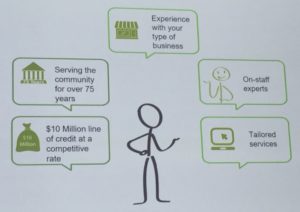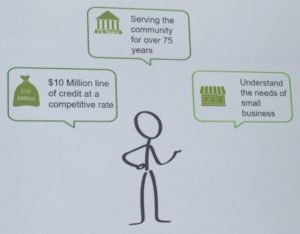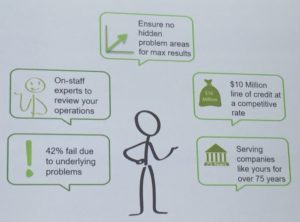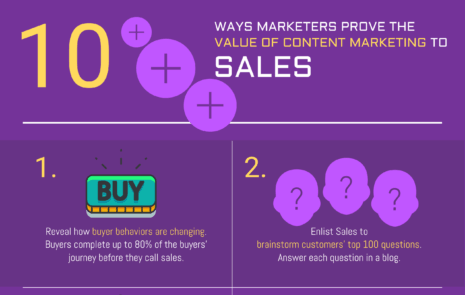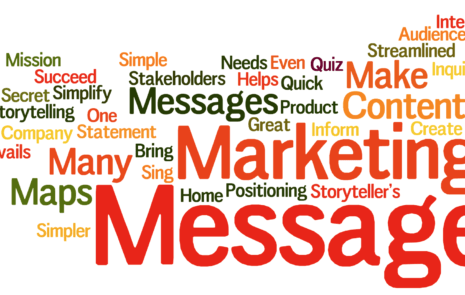
Which marketing message prevails? Quick quiz

If you have 4 potential story lines for your marketing message, which one works best?
This quiz question came from author and marketer Tim Riesterer, who made a big impression at the Business Marketing Association (BMA) 2016 Conference in Chicago.
Riesterer focused on how B2B marketers can create a business message that helps sales break through to customers and win a deal.
He asked the 600 marketers in the room to pretend that we were bankers. The task: making a presentation to a small business customer who needs a loan to get through the coming recession.
For our presentation, we could choose to present one of 4 story lines:
1. Identify the customer’s business need and present the bank’s credentials. The story goes like this: You offer a $10 million line of credit at a competitive rate, you’ve served the community for over 75 years, and you understand the needs of small business.
Here’s a sketch of that pitch:
2. Identify the customer’s business need, solve the problem the customer identified, and introduce value-added services. You add to the first message a few more ideas such as you have experience with your customer’s type of business, plus on-staff experts who offer tailored banking services.
Here’s what that pitch looks like:
3. Identify the customer’s business need, present credentials and introduce a new, unconsidered need. So after you offer a $10 million credit line and note you’ve served the community over 75 years, you tell your customer that 42% of businesses who get a loan to see them through a recession fail anyway. That’s why your bank helps you uncover hidden problems with on-staff experts.
Here’s that pitch:
4. Introduce the unconsidered business need first, and cover the other points later. Tell your customer first that 42% of businesses who get a loan to see them through a recession fail. That’s why you have on-staff experts to review operations and uncover hidden problems. You offer a $10 million loan and have been serving the community for 75 years.
Here’s a sketch of that pitch:
Which sales message would you choose: 1, 2, 3 or 4?
When Riesterer asked for a show of hands, the great majority of marketers in the room chose one of the first two pitches.
Many corporate presentations follow a story line like that: what you need, who we are, why we’re right for you.
But, surprise! Story line 4 is the real winner.
By leading with the unconsidered business need first, story line 4 increases the uniqueness of the pitch by 50%. Compared with the other pitches, it’s by far the most thought-provoking to customers.
The unconsidered need adds urgency and uniqueness to make the pitch stand out from others in the eyes of customers.
“You need to tell a story that lives in the unconsidered need,” Riesterer advised. “Urgency lives in the thing that the customer didn’t know.”
So, to make your sales and marketing message more effective, here’s what it takes. Start with a unconsidered need your customer has now. Then tell a provocative story that leads naturally to your solution.
It’s absolutely crucial to bridge your customer’s unconsidered need back to your solution. “If you tell the customer something surprising but don’t have a way to resolve it, you’re just a jerk.”
While marketers may look at known competitors as their biggest threat, “the true competitor is the status quo,” Riesterer observed.
That’s because a whopping 60% of B2B sales opportunities lead to no purchase decision. Six out of 10 times there’s an opportunity to sell, the customer ends up buying nothing.
That’s why it’s crucial for marketing and sales to sell against the status quo – the easy choice of taking no action. The status quo, in fact, is your biggest enemy.
Sellers who prevail to make the sale are usually the ones who helped the customers understand why they need to make a change. Specifically, show your customers why the status quo is untenable, what are the hidden costs and penalties, and how those disadvantages will loom even larger in the future.
“74% of executives buy from the seller who helps them see the need to change. Create a ‘why change?’ discussion,” Riesterer said.
“Tell customers something they didn’t know. Introduce unconsidered needs.”
The other buyers will hold a “bake off” to choose from more or less equal offerings.
When 6 out of 10 customers don’t buy any seller’s story, it’s clear that sales and marketing people desperately need a new and better way to tell their stories.
Does that mean your sales team will welcome this new story line with open arms? No way!
“Sales rejects a new way to tell a story, the way a body rejects a heart transplant,” Riesterer noted.
So it’s necessary, but not sufficient, to provide sales with a new business story.
You will also need to give your sales team several days of training and practice. When the salesforce feels ready to tell your business story in a new way, then you’re ready to roll out a new, thought-provoking, customer-challenging message.
What do great marketers do? “Make people feel smarter for having met you,” Riesterer said.
When you have the guts to be thought-provoking and challenge customers by leading with unconsidered needs, be ready to win more often!
Related Posts
Win Buyers’ Attention with the Right Size Message
When you share your business’ story, at first a buyer may give you only a few seconds of attention. As in the story of Goldilocks...
How Content Marketing Helps Marketing and Sales Win Together [Infographic]
How can Marketing and Sales win more? How can Marketing help Sales get more wins on the scoreboard — more customers, more deals and...
Top 10 Blogs of 2016 on Marketing Messages and Content Marketing
The top 10 blogs you chose to read in 2016 focused on marketing messages & content marketing. You zoomed in on 3 problems that vex and bedevil marketers...
Customer questions create raw material for your company story
Build your company story by answering customers’ questions When you lack a company story, everything about marketing grows a lot harder. Without a company story,...


